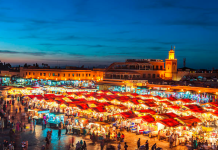In photo are (clockwise from top left) The Manila Times (TMT) Business editor Conrad Cariño, Tourism Promotions Board Chief Operating Officer Maria Anthonette ‘Tonette’ Velasco-Allones, Tourism Congress of the Philippines President Jose ‘Jojo’ Clemente 3rd, TMT editor Dafort Villaseran, and National Commission for Culture and the Arts Executive Director Oscar ‘Oca’ Getuya Casaysay. TMT SCREENSHOT
TOURISM industry leaders expect a more robust Philippine tourism this year, as the public now craves open spaces for rediscovering local and international travel destinations amid easing lockdowns and quarantines.
This was gleaned from The Manila Times webinar titled “PH Tourism: Where do we go from here” held on Tuesday, and attended by high officials from the Philippines Tourism Promotions Board, National Commission for Culture and the Arts (NCCA) and Tourism Congress of the Philippines as resource speakers.
By the end of 2022, foreign arrivals in the Philippines are seen to reach up to 1.3 million, Jose Clemente 3rd, president of the Tourism Congress of the Philippines, said.
The World Travel and Tourism Council (WTTC) recently reported that the Philippines’ tourism and travel industry bounced back in 2021, which is seen growing by 6.7 percent by 2032.
The report came as the global tourism value chain slowly recovers from the adverse impacts of the pandemic on the sector, particularly travel and aviation.
Clemente, however, said, “for us to know where do we go from here, we need to have a short look as to where we were for the past years.”
He said an estimated 1 million jobs in the tourism industry were lost during the pandemic.
Domestic tourism slightly rebounded with the loosening of entry requirements to popular destinations in the last quarter of 2021, but was again affected by the Omicron variant surge in early 2022.
But as soon as the government announced in late January that fully vaccinated tourists from countries that required no visas to enter the Philippines will be allowed entry subject to pre-arrival testing and having travel insurance with Covid coverage, foreign arrivals began to swell, reaching 313,050 as of April 24, 2022.
“We’re quite confident that we will be able to sustain tourist arrivals. We saw that Boracay has even recently surpassed its carrying capacity. So people really want to go out and travel now,” Clemente said.
The private sector is closely looking at the situation in Ukraine, according to Clemente.
“We hope that the situation will not escalate…as it really affected the air travel,” he said.
At the same time, Clemente said the private sector is closely monitoring prices and rates of tourism products; new strains of Covid; resumption of full flight frequencies; and usage by local government units of their additional budgets for tourism as a result of the Mandanas ruling.
“How we use this budget will determine how visible we’re gonna be for the tourism sector,” he added.
To ensure that the sector will be able to invite more tourists, Clemente cited the need to consider that travelers are now looking for things that will “expand their horizon.”
This means, he said, the need to push initiatives that will promote more experiential tours, culinary experiences and active and tactile activities that explain and show the culture and history of the Philippines on a deeper scale.
This was echoed by Oscar Getuya Casaysay, NCCA executive director.
“Our tourists are looking for immersive experiential opportunities…also inclusion,” Casaysay said.
Natural cultural treasures and historical travel destinations also need government and private support, funding and protection, he added.
“We’d like to teach people how to appreciate our history. This is one way to move forward,” he said.
“I’d like to encourage [the public] to go and travel and rediscover our faith and interests. Just be mindful and responsible travelers,” Casaysay added.
To allow the tourism sector to fully recover from the pandemic, Clemente also cited the need for close government and private sector partnerships as well as streamlined travel requirements both globally and domestically.
Plans and programs
Speaking for Tourism Secretary Bernadette Romulo-Puyat, Maria Antonette Velasco-Allones, Philippines Tourism Promotions Board’s chief operating officer, presented the government’s plans and programs to further boost the tourism sector amid the pandemic, and the measures it will implement to increase its contribution to the country’s recovering economy.
Allones cited the crucial role of the government’s vaccination program that has largely helped in the economic recovery, particularly in opening up tourism, one of the sectors hardest hit by border closures and travel restrictions.
“After two years since the outbreak of the pandemic and one year since we started vaccinating the population, we have finally crossed the threshold into the new normal,” she said.
The latest government data showed that about 17 million Filipinos have been fully vaccinated.
In terms of tourism workers, at least 97 percent of the targeted tourism workers have been fully vaccinated.
In key destinations such as Baguio City, Aurora, Busuanga, Puerto Princesa, Coron and El Nido, 100 percent of frontliners in the tourism sector are also fully vaccinated.
Since February 10 this year, Allones said the Philippines has been accepting fully vaccinated international travelers.
As of April 24, there have been 313,050 foreign visitors entering the country.
In fact, she said the country has breached its 7,000 daily average arrivals, reaching at least 7,200.
“Our confidence to reopen our border was brought about a number of factors, foremost of which is that we have successfully implemented stringent health and safety guidelines in our key destinations with the support of the Department of Health (DoH),” she noted.
This effort of the DoH, Allones said, was complemented by the DoT’s lead in the accreditation of all tourism-led facilities, ensuring that they comply with globally and nationally mandated health and safety protocols.
To keep the industry thriving while waiting for the resumption of international tourism, she added, the government launched several promotional campaigns “to ensure that we kept the Philippines as the top-of-mind destinations for different markets.”
To develop smart tourism, the DoT utilized digital platforms to expand its reach and create different ways of experiencing Philippine tourism, including the promotion of virtual destination videos and 360° virtual reality experiential tours, highlighting the country’s top tourist spots and attractions.
“These marketing campaigns are just part of the DoT’s 3 strategic directions that form the framework of the Reformulated National Tourism Development Plan (NTDP) spanning 2021-2022, which was really post-pandemic in the immediate and we have adjusted that to cope with the challenging times,” Allones said.
The NTDP calls for “Investing in a Competitive and Inclusive Tourism.”
Its vision is to “[d]evelop a highly competitive, environmentally sustainable and socially responsible tourism that promotes inclusive growth through employment generation and equitable distribution of income.”
The first step of this strategic direction is to promote a “safe, fun and competitive” tourism, Allones said.
To date, the DoT has validated more than 115 tourism circuits, which are redeveloped and recalibrated products across the country.
“They’re also currently developing more circuits to produce the best travel products and experiences which our regions have to offer.”
Some of these circuits that have already been launched include the Bike Trails of Bicol and Central Visayas, Camiguin and Misamis Oriental’s Green Adventure Loop, Davao’s Dive Tourism, Boracay’s Food Crawl, Soccsksargen’s Farm Tours and the Inter-regional Cuisine and Culture of Ilocos, Central Luzon and Cordillera.
Another strategic goal, according to Allones, is to pursue a “sustainable, inclusive and resilient” tourism that involves implementing programs that upgrade the micro, small and medium enterprises (MSMEs) in the tourism value chain, ensuring wider tourism access by increasing women’s and other marginalized sectors’ participation in tourism development.
She also noted the DoT’s move to strengthen the capacities of destinations for conservation and climate-smart investments.
“In order to fully attain a resilient, inclusive and sustainable tourism industry, we will set emergency plans and provide guidelines to local government units (LGUs) and the private sector in preparing crisis management plans based on UN WTO and Asean guidelines,” Allones said.
The “refreshed” NTDP aims “to enable an environment that will sustain the tourism sector and make [it] more resilient in the face of adversities like this pandemic, natural disasters and man-made crisis,” she added.












